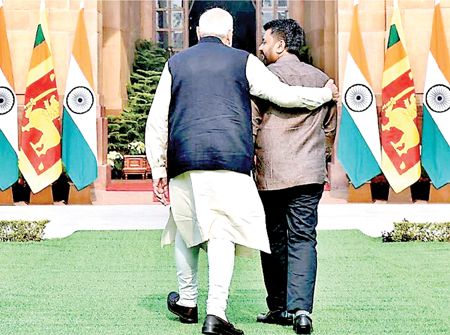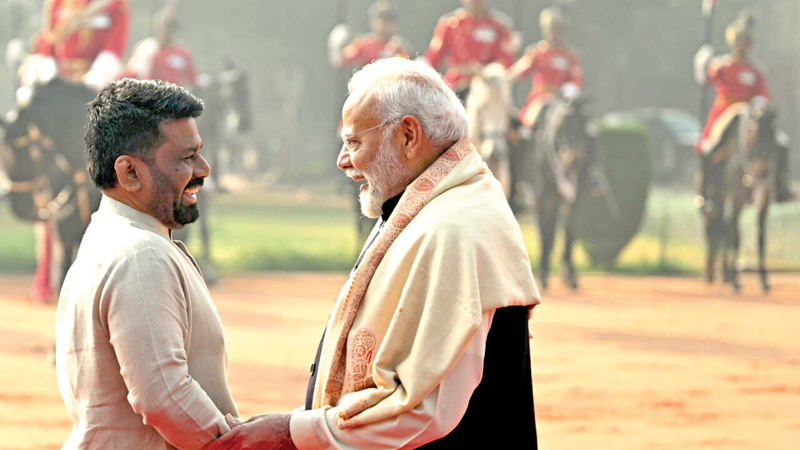By nature, time is unfathomable and in politics, it becomes even more subtler. Time endured by politicians generally resonated across their political journeys and it is against this background that one should look at the time of the visit of Narendra Modi, the Prime Minister of the world’s largest democracy, to Sri Lanka.
In general, the time of the visit of Modi to Sri Lanka coincided with the structural changes in the international order in which the shifting of the balance of power and the West’s odium against China has come to the fore as a result of many factors. Also, it is imperative to look at the currents emanating from Washington after the re-election of Donald Trump to the White House and the way how it challenges the Liberal euphoria in the West.
On the face of it, the time of Modi’s visit to Sri Lanka falls in a critical juncture of the global history. Domestic trajectories looming before the visit are more crucial as they embody the shift of political power from traditional political parties to a new party comprising multiple ideologies from Left to Centre.
Indo-Lanka relations have experienced many twists and turns over the past few decades, largely due to the geopolitical dynamics in South Asia. Despite the historical civilisational ties between India and Sri Lanka, their relationship has been significantly influenced by Sri Lanka’s geographical proximity to the Indian subcontinent. This closeness has been both a blessing and a curse for Sri Lanka throughout its history.
Until the end of the civil war in 2009, India’s primary concern regarding Sri Lanka stemmed from the ethnic conflict, particularly given India’s moral connections to its Dravidian population in the South. However, this issue shifted to the sidelines as Sri Lanka began to lean towards China, causing alarm in India.
India felt increasingly betrayed by the ambiguous diplomacy of former President Mahinda Rajapaksa, who engaged with China while distancing Sri Lanka from India. Although Gotabaya Rajapaksa attempted to present an “India First” foreign policy in 2020, Sri Lanka lacked a coherent strategy to strengthen its foreign relations, resulting in complicated narratives and uncertainties.
Different personalities
Looking at the political ideals of Indian Premier Modi and Sri Lankan President Anura Kumara Dissanayake may unfold the conspicuous differences between the two leaders, wherein Modi personifies the Hindutva nationalism espoused by Savarkar whose influences can be largely seen in the Indian Prime Minister’s vision on India as a civilisational state.
 On the contrary, President Dissanayake gained his electoral victory by denying the ethno-nationalist rhetoric, which served as a panacea for most of the politicians in Sri Lanka in its post-colonial setting. In short, President Dissanayake’s political victory is emblematic of a new change in the political culture in Sri Lanka devoid of ethic-religious rhetoric. Besides these ideological differences, both leaders share one commonality symbolised by their non-elitist upbringings challenging the dynastic politics of the sub-continent.
On the contrary, President Dissanayake gained his electoral victory by denying the ethno-nationalist rhetoric, which served as a panacea for most of the politicians in Sri Lanka in its post-colonial setting. In short, President Dissanayake’s political victory is emblematic of a new change in the political culture in Sri Lanka devoid of ethic-religious rhetoric. Besides these ideological differences, both leaders share one commonality symbolised by their non-elitist upbringings challenging the dynastic politics of the sub-continent.
President Dissanayake’s foreign policy articulated as the Udara Diplomacy assures a foreign policy based on national interest ensuring friendly relations with the neighbours. The Janatha Vimukthi Peramuna (JVP), the political party of President Dissanayake has a history of anti-Indian sentiments imbued with their antagonism on the Indo-Lanka Accord of 1987, but the wheel of time changed the anti-Indian perception as it was reciprocated by India when Mr. Dissanayake was invited to meet the Indian Foreign Minister in 2024, several months ahead of the Presidential Election.
The changes that have taken place since the last visit of Prime Minister Modi to Sri Lanka in 2019 denote the strong economic leverage of India, adding a staggering $1 trillion to its GDP. Its middle class has grown from 400 million to 550 million, which has elevated India into a high consumption-based society. Being the fifth largest economy in the world with the status as a connector of the West to the Global South, India’s role cannot be ignored in global affairs.
The proposed defence agreement between the two countries was likely to be signed during this visit, when the article was being written before the visit, adding much significance to the geopolitical plateau of the region. This enhanced defence cooperation comes against the backdrop of India’s concern about China’s expansionist military presence in the Indian Ocean Region (IOR), which India perceives to be a threat.
On the other hand, the defence collaborations between India and Sri Lanka have a troubled history marred by the presence of Indian Peace Keeping Forces in Sri Lanka until 1990, which impeded the successive Indian Governments to forge defence cooperation with the island nation. But, the geopolitical tug-of-war between New Delhi and Beijing seemed to have altered India’s stance by opening the path for defence collaboration.
Neighbourhood First policy
Sri Lanka remains an integral part of Modi’s Neighbourhood First policy, akin to the Gujral doctrine in the 1990s, a set of principles that moulded India’s foreign policy towards its immediate neighbours. By emulating the principle of then India’s Minister of External Affairs Inder Kumar Gujral, Modi cemented his Neighbourhood First policy, which follows a congenial attitude towards India’s neighbours – Sri Lanka, Bangladesh, Bhutan, Nepal and the Maldives.
This attitude was reflected when India was the first to extend help during Sri Lanka’s economic crisis in 2022. Without adhering to a debt-trapped diplomacy, India reconstructed its position in Sri Lanka by supporting Colombo’s endeavour to reach the IMF.
The visit of Indian Prime Minister Modi will unleash the stage for a historic shift as the time of this visit is equally relevant for both countries. Kala Chakra or Wheel of Time was the theme chosen by the Ministry of External Affairs in India in the recently concluded Raisina Dialogue in New Delhi, a showcase of India’s underlying posting in the emerging World Order and the wheel of time provides in impetus to shun the bad memories by generating new partnerships.
India-Sri Lanka relations with all its concomitant worries ranging from geopolitics to fisherman disputes stand a pivot as both countries share a civilisational bond, that cannot be penetrated by external elements. Thus, Modi’s visit to Sri Lanka is timely as Indo-Lanka relations have moved forward from the early developments under different regimes.
The writer is a lecturer at the Faculty of Law, General Sir John Kotelawala Defence University, Sri Lanka






